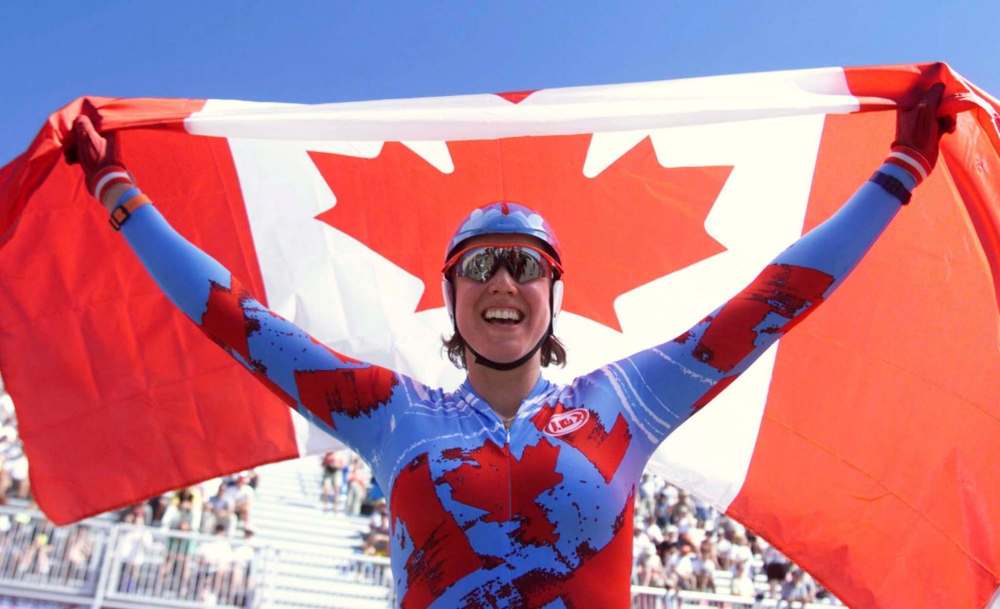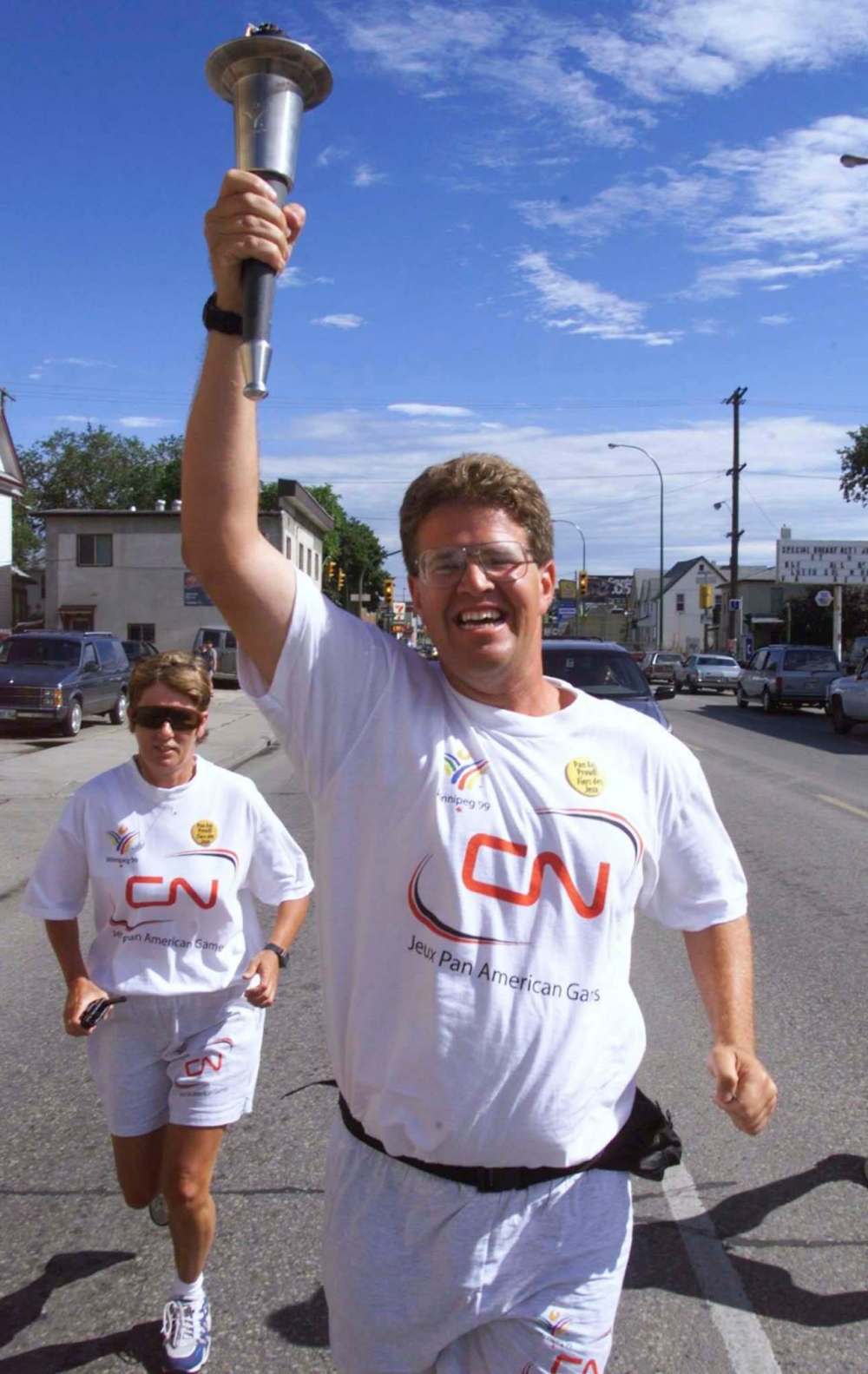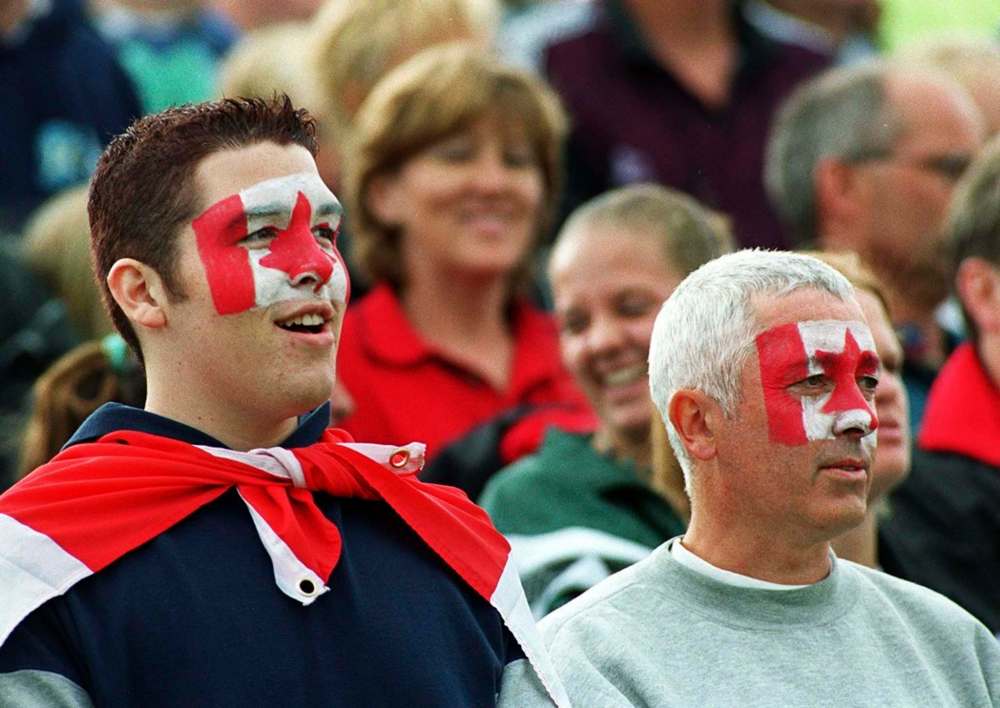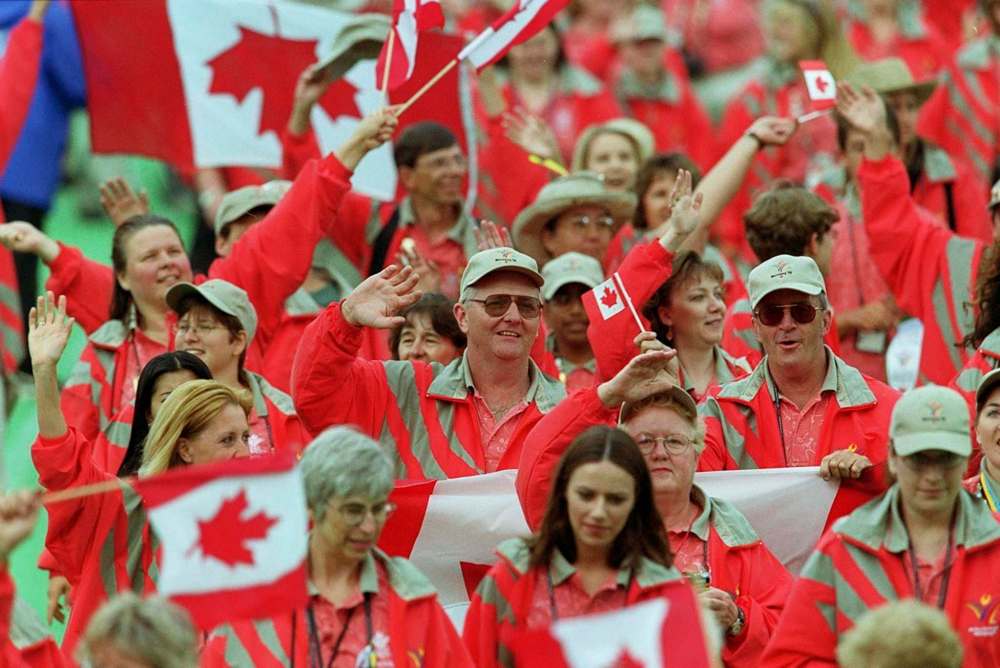Pan Am flashback
Legacy of 1999 games that established Winnipeg as the 'small city that could' still being felt
Advertisement
Read this article for free:
or
Already have an account? Log in here »
To continue reading, please subscribe:
Monthly Digital Subscription
$0 for the first 4 weeks*
- Enjoy unlimited reading on winnipegfreepress.com
- Read the E-Edition, our digital replica newspaper
- Access News Break, our award-winning app
- Play interactive puzzles
*No charge for 4 weeks then price increases to the regular rate of $19.00 plus GST every four weeks. Offer available to new and qualified returning subscribers only. Cancel any time.
Monthly Digital Subscription
$4.75/week*
- Enjoy unlimited reading on winnipegfreepress.com
- Read the E-Edition, our digital replica newspaper
- Access News Break, our award-winning app
- Play interactive puzzles
*Billed as $19 plus GST every four weeks. Cancel any time.
To continue reading, please subscribe:
Add Free Press access to your Brandon Sun subscription for only an additional
$1 for the first 4 weeks*
*Your next subscription payment will increase by $1.00 and you will be charged $16.99 plus GST for four weeks. After four weeks, your payment will increase to $23.99 plus GST every four weeks.
Read unlimited articles for free today:
or
Already have an account? Log in here »
Hey there, time traveller!
This article was published 16/08/2020 (1937 days ago), so information in it may no longer be current.
Five-thousand-eighty-three athletes. Forty-two nations. Three-hundred-thirty events. Thirty-four different sports. Seventeen days. Nearly 20,000 volunteers. One city transformed into a sporting mecca.
Twenty-one years ago, Winnipeg hosted an athletics extravaganza: the 1999 Pan American Games. Athletes from all over the world descended on the city and surrounding towns, looking for glory in their diverse disciplines — aquatics to archery, tennis to triathlon, rowing to rugby.

The Games — which returned to Winnipeg for the first time since the 1967 edition — opened with much pomp and circumstance on July 23, 1999, as 40,000 people packed Winnipeg Stadium for an epic, nearly three-hour-long opening ceremony.
The festivities featured 1,000 dancers dressed to represent the four seasons, a visit from Princess Anne — “she was charming,” then-mayor Glen Murray said at the time, “even after spending the whole day on a plane she still looked wonderful,” — and O Canada performed by Chantal Kreviazuk.
“The 13th Pan American Games officially opens tonight in the happiest possible way, with Canadian gold already in the medal bank, more victories on the horizon and host city Winnipeg in a mood to party like its 1967,” features editor Buzz Currie wrote on the front page of a 12-page, multi-writer Free Press special previewing the Games.
Pan Am imperfect: snub, steroids and skeeters
While the Games were an overall success, they weren’t without snags, snubs, SNAFUs, subterfuge, and even swarms.
While the Games were an overall success, they weren’t without snags, snubs, SNAFUs, subterfuge, and even swarms.
Games organizers paid Canadian gold medal-winning sprinter Donovan Bailey $200,000 to endorse the games and compete for Canada, but they quickly turned out to regret giving him fast cash.
Bailey — who set a world record by running a sub-10 second 100-metre at the 1996 Olympic Games in Atlanta — participated in the 4 x 100 relay, but didn’t give fans a chance to see him streak down the track in his speciality event.
Bailey finished third in a late-June 100-metre qualifier behind Bruny Surin and Brad McCuaig. When Surin decided to run in Europe instead, Bailey was asked to take Surin’s place but declined, saying he hadn’t trained. He later claimed he’d never been selected to participate.
Another thing Bailey didn’t participate in was the opening ceremonies, stating “I’ve never been at an opening ceremony because it’s five or six hours of ceremonial type things and us sprinters, when we’re competing, we have to rest our legs in order to bring back a medal.”
Bailey’s actions didn’t go over well with many, including with three-time rowing gold medalist Marnie McBean. She told the Free Press he should give the 200 grand to Canadian athletes and compared his behaviour to a “child invited to a birthday party who refuses to go because he knows he is not going to get the biggest piece of cake.”
Bailey wasn’t the only Canadian athlete to cast the country in the less-than-ideal light: Canada won the gold medal in inline hockey, but was stripped of the win on Aug. 2 after goaltender Steve Vezina tested positive for a number of banned substances, including the anabolic steroid Nandrolone.
“I didn’t know all the rules,” Vezina claimed at a news conference, saying he’d taken Nandrolone to help his ice hockey career — in 1998-99, he played 20 games for the International Hockey League’s Utah Grizzlies — and didn’t know it was banned in international competitions.
While Bailey bugged organizers and Vezina bugged his teammates — who were forced to give back the $3,000 in prize money they’d each earned by medalling — a ubiquitous insect bugged attendees.
Heavy rain in the weeks leading up the Games, followed up by hot temperatures and high humidity, led to a large mosquito infestation with the pests migrating from as far as eight kilometres outside city limits.
Trap counts reached 330, which meant anyone outdoors could be bitten between 10 and 15 times per minute, entomologist Randy Gadawski said at the time, obviously not ideal for athletes competing or fans watching.
Winnipeg was in full-on Pan Am party mode. Prior to the lighting of the torch, hundreds took to the streets to watch the 99-runner torch relay and thousands flocked to Old Market Square for an all-day, 16-act Mardi Gras concert.
“After 6 p.m., the crowd in the beer gardens and all over Old Market Square swelled as ordinary Winnipeggers got off work and the sun began to hide behind the Exchange District’s stately, old buildings,” Bartley Kives reported. “By the time Winnipeg’s Rockalypso began pounding out their infectious… beats around 7 p.m., the Square was completely packed.”
Indeed, the hype was real, and those who didn’t get tickets in advance were scrambling: ticket sales — which had been about 7,000 per week in the lead up to the Games — jumped to 7,000 per day in the days before and after the ceremony.
“The city was buzzing,” Janet McMahon — who was the Games’ sports operations manager and is now Sport Manitoba’s director of sport — said this week when reached via email.

“You would have had to be living under a rock to not know that Winnipeg was hosting the Games,” she said. “The pageantry, street and bus signage, venue builds, local business decalling… and just noticing the out-of-town and country visitors. Everyone was wearing the Games’ credentials around their necks.”
For the two weeks thereafter, one could barely turn around without bumping into elite athletic events. Competition was hot at 32 different venues: Assiniboine Park, the Convention Centre, Pan Am Pool, Winnipeg Arena, University Stadium and many more.
Events weren’t confined to within the Perimeter, either. Birds Hill Provincial Park hosted cycling and triathlon, Minnedosa was the site for rowing and canoeing and Gimli was the gathering place for sailing.
As for the hardware, the 618 Canadian athletes fared well and graced the podium often. Combined, they captured 64 gold, 52 silver, and 80 bronze medals for a total of 196 pieces of hardware featuring the well-known wheat sheaf logo. That total outpaced all other countries except the U.S.

As for Manitobans, they certainly enjoyed some home cooking. Fifty-one Manitobans competed and 24 of them captured medals in their own backyards.
Among the Manitoban medallists were cyclist Tanya Dubincoff — who won a pair of golds in the 500-metre time trial and the sprint and was also Canada’s flag bearer at the opening ceremony; Kelly Hand — who won gold in the women’s laser radial sailboat race; Emma Robinson — who won gold in rowing pairs with her partner from Vancouver; and Kelly Stefanyshyn — who won gold in the women’s 100-metre backstroke.
Nikki Jenkins won the silver in 78-kilo judo, while Dominique Bosshart, Harry Gerow, and Kara Solmundson captured bronze in taekwondo, prone riflery, and badminton, respectively.
The Games received extensive coverage and thrust Winnipeg squarely into the international spotlight, with CBC’s coverage anchored by Brian Williams.
And Winnipeg looked good in that spotlight, thanks in no small part to the nearly 20,000 of volunteers who chipped in to ensure the Games ran smoothly and was a financial success.
Known colloquially as the “Salmon People” because of their pink jackets and shirts, these folks showed their civic pride and helped the Games generate an $8.9-million financial surplus by taking on a bevy of roles as diverse as the countries competing.
The author connected with more than 50 former volunteers through social media who shared fond memories about their experiences 21 years ago.
This is by no means an exhaustive list, but they recalled being: baseball umpires, bus drivers, chauffeurs, food services directors, timekeepers, marathon course marshals, nurses, logistics specialists, public address announcers, tennis line officials, technology managers, security guards, schedulers and statisticians.
One even recalled doing white glove service for Rae & Jerry’s at an event Princess Anne attended in St. Francois Xavier.
One thing was unanimous: they all reflected on the good time they had and how happy they were to do their part.

“It was a fun time, I got to meet a lot of athletes from all around the world and trade pins with all of them,” commented Cheryl Strangeland, who worked as a dental assistant.
Arlene Stanlake, who worked in logistics, said “We supplied foodstuffs, water, etc. to different sections. What I really enjoyed was seeing the athletes from around the world and trading hats with them. The job was fun and the people were nice. After the Games were complete, we were treated to a free concert. It was a great experience.”
“I drove athletes and officials around to different venues and sometimes just to go shopping,” said Doug Gow. “I enjoyed it immensely. Some people were very nice and chatty and others just wanted to get from A to B.
The most interesting was a young boxer who had just finished a bout,” Gow continued. “He was pretty beat up and I assumed he lost. He had just won the title, and said the classic line: ‘you should have seen the other guy.’”
“For their hours of labour they received very little,” Free Press Pan Am reporters Leah Janzen and Kim Guttormson wrote. “A uniform of questionable fashion merit, a couple of hats and hopefully the satisfaction of knowing they were the backbone of a huge organizational machine that conceived, planned, and made the Games a rousing success.
“By the end of the Games, nearly 20,000 hearty souls had put their stamp on the competition, showing visitors Friendly Manitoba is more than just a slogan on our licence plates.”
“We couldn’t have done it without them,” Games COO Bob McMahon said in the same article. “There were friendly, accommodating, flexible. They were a spectacular success.”
“Volunteers made the Games,” Janet McMahon agreed, crediting them for shouldering the “frightening” amount of logistics required to run so many venues and events.
“It was the volunteers that went above and beyond to make it work,” she said. “They made good decisions all with a friendly smile,” and that they proved proves Winnipeg can pull off enormous events “without a hitch.”

Another thing that was a success was the large-scale investments made into new and existing sporting facilities, many of which still benefit the city to this day.
The Pan Am Pool, built for the 1967 Games and upgraded in 1999, continues to be a Prairie hub for aquatic competitions and is continually being improved.
Our jewel of a downtown ballpark — now known as Shaw Park but built specifically for the games as CanWest Global Park — has been the home of the Winnipeg Goldeyes ever since and remains a superb place to be on a scintillating summer evening in non-COVID times.
The Investors Group Athletic Centre at the University of Manitoba, also built for the Games, is one of the cornerstones of the 30,000 student university’s sports programs.
The MHC Equestrian Centre at Birds Hill, which received upgrades, continues to host clinics, competitions and camps.
Beyond the bricks-and-mortar, hosting a successful Games instilled a sense of pride in Winnipeggers, a sense that’s often far too fleeting.
“In a city that is famous for beating itself up and generally feeling inferior, the Pan Am Games were a rare respite where Winnipeg took centre stage — nationally and internationally — and we all felt good about ourselves and the community,” Free Press sports columnist Paul Wiecek wrote in a 2009 piece taking a look at the Games’ payoffs a decade later.

In 2015, Toronto Star writer Paul Hunter did a piece prior to the Games in that city on whether hosting one can truly change a locale.
In the article, Hubert Mesan — who worked on Winnipeg’s Games bid and was later president of Travel Manitoba — told Hunter “it had been a long time since the city had had any major events or major initiatives that would capture the entire community” and that there was “a lot of negativity and cynicism” as the original Jets had left for Phoenix and Winnipeg’s economic base was eroding.
The Games elevated Winnipeggers’ pride, Mesman said, and heightened Winnipeg’s profile as a tourist destination. Mike Moore, a bid committee vice-chair, even went so far as to tell Hunter it represented “a rebirth” for the city.
Regarding how the Games changed Winnipeg, we’ll give Janet McMahon the final word.
“The Games absolutely changed the identity of Winnipeg,” she wrote. “It was a small city that could. The positive feedback from the Central and South American countries was amazing. I will never forget how many comments I got about how beautiful the city was. They were so impressed with our green spaces, the trees and gardens. The weather really helped — it was hot and beautiful the whole time.”



